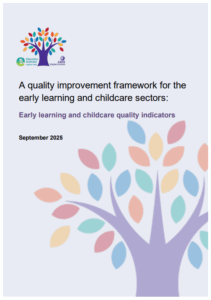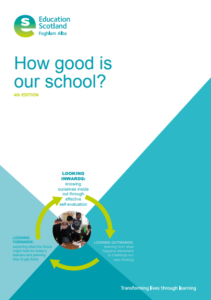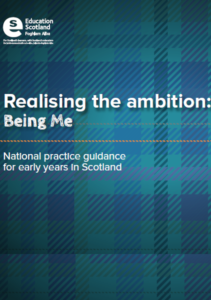Self-Evaluation
– Reflecting on Practice
Leadership and Management of Staff and Resources p5 – Self-Evaluation, Quality Assurance and Implementing Change
Well-considered, purposeful self-evaluation enables us to deliver high-quality care and learning tailored to children’s and families’ needs and choices. We ensure the views of children, families and partners inform improvement and are central to our self-evaluation process. Our leaders evidence where these views inform change, secure improvement and lead to positive outcomes for children and families. We reflect well together and use these reflections to bring about positive change. Our quality assurance and moderation activities, which include well-timed monitoring and data gathering, have agreed standards and expectations that are understood by all staff. Highly effective use is made of evidence to draw conclusions about the quality of the provision and identify suitable approaches to improvement. Sustainable change is achieved because there is an appropriate pace of change. Highly effective practice is identified and shared within and beyond the service to promote improvements which have led to positive outcomes for children. Leaders ensure that high-quality learning through play is at the heart of improvement planning. Continuous improvement, success and achievement for all children are central to the planned implementation of strategies for improvement. These are relevant to local, national and international advice, and research is used effectively to support the thoughtful changes.
p8
How do we know our quality assurance processes improve outcomes for children and families?
How well do staff understand their responsibility in improvement through self-evaluation?
To what extent are staff empowered to make changes?
How has the use of best practice documents and national guidance led to improvement in children’s experiences and outcomes?
How have we used children’s voices to evaluate and inform our practice and provision?
How do we engage our families and children to ensure they have a role in our improvement journey?
Leadership of continuous improvement p17 – Planning and Continuous Improvement
Ongoing critical reflection and robust self-evaluation involves all staff, children and stakeholders. This leads to clear plans for improvement with specific, measurable targets to support the implementation of well-informed change.
Senior leaders guide and manage the direction and pace of change very successfully. Highly effective strategies are used to monitor and evaluate the impact of change, drawing on a range of evidence, including self-evaluation and inform future actions. All those involved with the setting are clear about improvements and the positive impact on the quality of ELC provided.
p18
How well do we use evidence-based research, local and national guidance to inform our pedagogy, practice and improvements?
How well do we support one another, share practice and take responsibility for leading improvements?
In what ways do we use robust self-evaluation to make decisions about professional learning and improvement?
In what ways do senior leaders role model and influence high-quality practice?
How well and in what ways does monitoring of the quality of the early learning and childcare (ELC) we provide influence change and improvement?
To what extent does professional learning influence changes to our practice that impact positively on outcomes for children? How do we know?
In what ways do we support children, staff and stakeholders to share their views, experiences and opinions? To what extent do their views influence change?
How effectively do we engage others to develop a shared vision and purpose for our setting?
How well do our vision and values underpin the work of the setting? What impact do they have on improving the quality of ELC we provide?
Safeguarding and child protection p65 – Legislation, Policy and Guidance in Practice
Our robust approach to self-evaluation fully informs our arrangements for recognising, responding to, recording and reporting concerns about children’s wellbeing or safety. We use legislation, national guidance and policies to support our self-evaluation. We proactively take account of new information, policy developments and emerging issues to improve our practice
p69
How well do our self-evaluation and quality assurance processes support improvements in safeguarding?
To what extent do they strengthen areas such as staff and volunteer recruitment, personal planning and practice in place to keep children safe?



